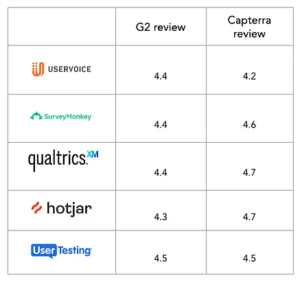Product Management Toolkit series: User Feedback Tools

User feedback is crucial for product managers to understand the needs and wants of their users. In this blog post, we’ll explore how product managers can collect user feedback and some popular user feedback tools that can help you collect and analyze feedback from your users.
There are several types of feedback mechanisms that software product managers can use to gather feedback from their users. Here are some common types:
1. Surveys: Surveys can be conducted through email, in-app popups, or third-party survey tools. Surveys are useful for gathering both quantitative and qualitative feedback on specific product features, user experience, and overall satisfaction.
2. Feedback Forms: Feedback forms are typically located within the product itself, allowing users to easily submit feedback on specific features, issues, or suggestions. This feedback can be used to improve the product and enhance user experience.
3. User Testing: User testing involves having users test the product and provide feedback on its usability, functionality, and overall experience. This type of feedback mechanism is valuable for identifying user pain points, uncovering bugs, and improving the user experience.
4. Customer Support Interactions: Customer support interactions, such as chatbots, email exchanges, and phone calls, can provide valuable feedback on product issues, bugs, and overall satisfaction
5. 1:1 interviews and focus group discussions: They allow for more personal and in-depth conversations . These can be good forums for generating new ideas too.
Top-rated platforms and their features
Here are a few top-rated feedback tools that product managers can use to collect and analyze feedback from their users:
1. Uservoice:
Uservoice is a popular tool that enables you to collect customer feedback through surveys, user testing, and feedback forms. It offers features such as customizable widgets, real-time updates, and user segmentation to help you understand your users better.
2. Surveymonkey:
Surveymonkey is another widely used feedback tool that allows you to create surveys and collect feedback from your customers. It offers a wide range of templates and question types to help you get the feedback you need.
3. Qualtrics:
Qualtrics is a comprehensive experience management platform that enables you to gather feedback from your customers at every touchpoint. It offers advanced features like sentiment analysis, predictive intelligence, and more to help you understand your users better.
4. Hotjar:
Hotjar is a powerful tool that allows you to understand how users interact with your website or app. It offers features such as heatmaps, session recordings, and feedback polls to help you identify user pain points and opportunities for improvement.
5. UserTesting:
UserTesting is a user research platform that enables you to conduct remote user testing and gather feedback from your target audience. It offers features like video recordings, surveys, and participant recruitment to help you get the insights you need.

Other platforms worth considering include Userzoom, maze, and User interviews. Each of these platforms has its own unique features and strengths, and product managers can choose the one that best suits their needs.
Conclusion
User feedback tools play a critical role in helping product managers stay connected with their users and understand their needs and wants. Regularly collecting and analyzing user feedback enables product managers to make data-driven decisions and create products that cater to their target audience. Moreover, building strong relationships with customers through user feedback can lead to higher customer satisfaction and loyalty.



